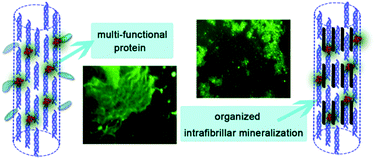Organized intrafibrillar mineralization, directed by a rationally designed multi-functional protein†
Abstract
Taking lessons from the structure-forming process of biominerals in animals and plants, one can find tremendous inspirations and ideas for developing advanced synthesis techniques, which is called bio-process inspired synthesis. Bone, as a typical representative of biominerals, is constituted of mineralized collagen fibrils, which are formed under the functions of non-collagenous proteins (NCPs). Intrafibrillar mineralization is the consequence of a synergy among several NCPs. In the present study, we have designed a multi-functional protein, named (MBP)–BSP–HAP, based on bone sialoprotein (BSP) and hydroxyapatite binding protein (HAP), to mimic the intrafibrillar mineralization process in vitro. The three functional domains of (MBP)–BSP–HAP provide the artificial protein with multiple designated functions for intrafibrillar mineralization including binding calcium ions, binding collagen, and binding hydroxyapatite. Platelet-like hydroxyapatite crystals periodically arranged inside the collagen fibrils have been achieved under the function of (MBP)–BSP–HAP. The mechanism of intrafibrillar mineralization directed by the multi-functional protein was proposed. This work may not only shed light on bio-process inspired approaches for more economic and efficient biomimetic synthesis, but also be helpful in understanding the natural process of bone formation for bone regeneration and tissue repair.


 Please wait while we load your content...
Please wait while we load your content...